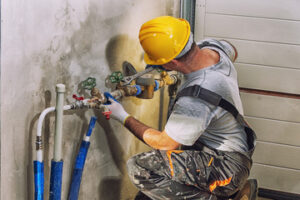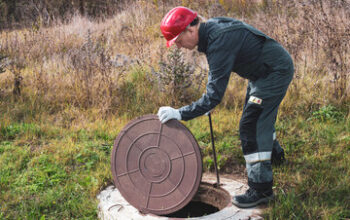Plumbers Sarasota install and repair the pipes that carry water, gas, and waste to and from homes and businesses. They must have excellent critical thinking skills to assess problems and find solutions.
They also must be able to read and interpret blueprints. Most plumbers complete an apprenticeship combining classroom instruction with paid on-the-job training. After gaining experience, they must pass an exam to become licensed.
When your faucet handle is loose, it can grind away the valve stem that it screws to and cause leaks. You can fix this yourself by tightening the screw that holds the handle in place. First, you must make sure the water is turned off. It’s a good idea to cover the drain with a rag or piece of tape to prevent screws and small parts from falling down the sink drain and getting lost forever.
Once the water is shut off, you’ll need to clear out the space under your sink. Remove any cleaning supplies and kitchen items to give yourself room to work. You’ll also need to have tools and materials ready, including an adjustable wrench, screwdriver, replacement washers or O-rings, and a basin wrench (if necessary).
Start by turning the handle clockwise to loosen it. You may need to remove the decorative cap on the handle or use a screwdriver to expose a screw inside. The screw may be a flat-head or Philips-head screw. If so, you can tighten it using a standard screwdriver or wrench. If the screw is stripped or otherwise unusable, replace it with a new one.
If the screw is fine, lubricate it by applying penetrating oil like WD-40 around the outside and any exposed crevices on the handle. Once lubricated, you can attempt to tighten it by wriggling the handle up and down. If it’s still loose, you can try spraying more oil into the handle’s crevices or removing the handle entirely and soaking it in vinegar to clean and re-lubricate.
If you cannot tighten the screw, you can re-tighten the retaining nut that holds the handle in place by hand or with a wrench. Wrap a little plumber’s tape around the female threads that the nut screws onto for a stronger and longer-lasting hold. When you’re done, physically inspect the handle to ensure it’s firmly seated. You can also reassemble the entire faucet and turn on the water supply to test your repair. If it’s working, you can enjoy your sparkling, functional faucet!
Faucet Valve
If you are dealing with a faucet with an ugly or cracked handle or one that drips all the time, it may be time to replace the valve. A faucet valve is usually made of brass or stainless steel and has several moving parts that are prone to wear and tear over the years. A plumber can repair a leaky or noisy valve by replacing its rubber seals, washers and sometimes even the stem or ball itself.
Valve technology has evolved over the years. Older faucets, often still used in outdoor spigots, employed compression valves that operated by turning the handle to raise and lower a stem that pressed a grape-sized rubber plug into a metal seat. This type of valve worked well, but it had a few problems – the compression washers wore out and the operation twisted and ground the stem and seat together, shortening the life of the faucet.
Most modern kitchen and bath faucets use a cartridge-style valve that is inserted into the body of the faucet. The replacement is easy to do, requiring no major disassembly or plumbing skills. This type of faucet eliminates the need for a separate shutoff valve for the hot and cold water supply lines because temperature mixing occurs outside the faucet body.
Look under your sink to locate the shutoff valve that is located on the water supply line that feeds the faucet you are working on. Close the valve by rotating the handle until it stops or twisting the levers if they have levers instead of handles. After closing the valve, shut off the water at the main house hydrant, usually in the basement or near the water meter. If you do not know where this valve is located, check with the home owner’s association or local building inspector for information.
Faucet Seat
A leaking faucet that is triggered by turning on the water, especially if it leaks both when it’s off and on, may indicate an issue with the valve seat. This is a fitting inside the valve that sits directly above the washer that opens and closes to allow water through. The valve seat can wear out and become eroded, which can cause the seal to not be tight enough to stop a leak.
The first step in addressing this problem is to turn off the water supply under the sink. Then, you need to remove the handle and any other parts that are attached to it. This can be done with a screwdriver and water-pump pliers in most cases. Next, you should inspect the valve seat for nicks or other damage that could be causing the leak. If it appears that the seat is damaged, you can replace it with a new one. These are inexpensive and available at most plumbing supply outlets. If your inspection reveals that the seat is not damaged, you can try to reface it with a tool that is sold at most hardware stores. This is not easy to do, however, and is typically a job best left to plumbers who have experience with this type of work.
If the valve seat is still good, it’s possible that the issue is caused by hard water and sediment buildup. It’s also possible that the washer is not fitted tightly against the seat, or chemicals in your water are affecting its ability to fit tightly against the seat.
Replacing a valve seat is an involved repair job and not the best first project for someone who is just starting to work on plumbing projects. However, it’s not as difficult as it looks and is an excellent way to save money compared to calling in a plumber. It’s also an excellent DIY project to tackle with your kids if you have some extra time on a weekend. This is a great way to teach them the value of saving money and taking pride in the work they do.
Faucet Cylinder
Cartridge faucets are common in commercial facilities because they offer a wide range of flow and temperature options and can handle hard water. They are also easy to repair if the cartridge is damaged. Choosing the right replacement cartridge is critical because it must match in size and number of splines (or notches) on the stem with those on the faucet handle, and be compatible with the type of underbody used by the faucet. A mismatched cartridge can cause water to be wasted, cross-flow between hot and cold water, and provide a breeding ground for bacteria.
The cartridge is a plastic cylinder with notches on the side and a stem on top. It’s not visible until you remove enough pieces of the faucet, and is usually secured by a small screw, or hex wrench, that is located under a decorative collar on the outside of the fixture. Once you have the decorative piece removed and the retaining screw is loose, the cartridge should pull out easily with a light tug. If it’s not pulling out, the adjusting ring may need to be tightened, or the cartridge itself may be damaged.
Once the cartridge is removed, the adjusting ring can be tightened with a spanner tool that may come with the repair kit. The plastic cam and packing can be replaced if needed, and the ball valve should be replaced with a new one if it has cracks or scratches. Depending on the model, rubber seats and springs may need to be replaced as well.
Using heatproof plumber’s grease, apply a thin coat to all the O-rings on the cartridge and stem. Once the adjusting nut and a few other parts are reinstalled, slide in the new cartridge, making sure it is oriented correctly. Screw in the retaining nut, replace any screws or snaps on the decorative piece and handle, then turn on the water at the shutoff valves to test the faucet. If any leaking or problems occur, shut off the water, remove the handle and reassemble the faucet in reverse order.


